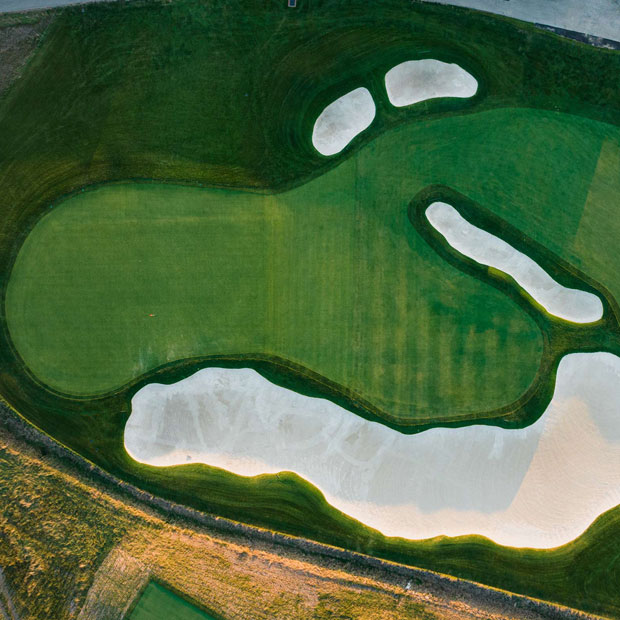History and competition: Wykagyl
A visit to Wykagyl Country Club with Jon Cavalier


A historic competition staged at a Golden Age gem of a course. That combination always works for us, and that is exactly what we have with this year’s Met Open at Wykagyl Country Club in New Rochelle, NY. Such an occasion called for a Field Report, and it just so happened that friend of The Fried Egg Jon Cavalier (@LinksGems on Twitter and Instagram) was on his way to play in the Pro-Am. As always, he generously shared his findings.

The iconic bridge at Wykagyl C.C. - Photo Credit: Jon Cavalier
First, some background. Wykagyl has rich history from both an architectural and competitive perspective. The course was originally laid out by Lawrence Van Etten in 1905. In 1919, Donald Ross was brought in to improve several holes. In 1930, A.W. Tillinghast added his touch, eliminating two holes and replacing them with two holes as a part of a broader reconfiguration of the course. Wykagyl is one of the many architectural hybrids that we find particularly fascinating. Jon describes the vibe, “Very old school, with a ton of charm. One of those courses and clubs that really does feel frozen in time.”
In fact, Wykagyl has not been frozen in time. Like many courses of the era, trees grew, greens shrunk, and character was lost. Happily, the restoration trend arrived at the club in 2003, and the leadership wisely tapped Bill Coore and Ben Crenshaw to restore their treasured layout while addressing drainage and irrigation issues. We caught up with Bill Coore to discuss the project. “I love the way the golf course rests on the land,” muses Mr. Coore. “It is spectacular land and the greens have beautiful contours. Reminds me of Yokohama’s West Course.” The C&C team performed a full restoration, skillfully balancing original architectural intent with the need to address challenge and playability for the modern game. “We removed trees, which opened up vistas and improved air flow. It also reintroduced wind into play.” Work was completed in 2006, with players once again enchanted.

Coore & Crenshaw sketches of the 7th and 8th hole - Credit Wykagyl C.C.
The club’s competitive history matches its architectural pedigree. The membership has consistently held its own against other clubs in the Met Area, as well as hosting a steady stream of events. Notable amateurs and professionals have roamed the fairways, including Harry Vardon, Ted Ray, Walter Hagen, Bobby Jones, Ben Hogan, Sam Snead, Nancy Lopez, and Annika Sorenstam. The tradition continues with the 103rd playing of the Met Open, mixing pros and top amateurs. As one of the oldest championships in America, The Met Open is perfectly at home at the restored Wykagyl.
Back to Jon, post-Pro Am. “The strengths of the course are a brilliant routing and outstanding variety. The Met Open actually switches the nines, making the 9th the last – a great finishing hole and much better than the normal 18th, which is the weakest hole on the course. As to variety, the course truly has 18 holes that are all totally unique. In particular, the par-3s are exceptional – all different distances, all different types – and the par-5s are terrific.” Those who follow Jon on social media know that he is a man of both quality and quantity. It was no surprise, therefore, that when we asked him for a favorite hole, he gave us two.
HOLE #4 – Par 3 – 144 yards
“The shortest hole on the course, which plays over a rocky valley to an awesome wide-but-shallow green that slopes back left to front right.”
{{content-block-wykagyl-country-club-profile-001}}
HOLE #9 – Par 5 – 494 yards
“Nicknamed Cardiac Hill, the tee shot on this hole is into a huge hill with the second shot to the reachable green being blind over the top. The green is in a natural amphitheater right at the foot of the clubhouse – I think Harry Vardon called it his favorite finishing hole.”
{{content-block-wykagyl-country-club-profile-002}}
Leave a comment or start a discussion
Engage in our content with thousands of other Fried Egg Golf Members
Engage in our content with thousands of other Fried Egg Golf Members
Get full access to exclusive benefits from Fried Egg Golf
- Member-only content
- Community discussions forums
- Member-only experiences and early access to events




.webp)





Leave a comment or start a discussion
Lorem ipsum dolor sit amet, consectetur adipiscing elit. Suspendisse varius enim in eros elementum tristique. Duis cursus, mi quis viverra ornare, eros dolor interdum nulla, ut commodo diam libero vitae erat. Aenean faucibus nibh et justo cursus id rutrum lorem imperdiet. Nunc ut sem vitae risus tristique posuere. uis cursus, mi quis viverra ornare, eros dolor interdum nulla, ut commodo diam libero vitae erat. Aenean faucibus nibh et justo cursus id rutrum lorem imperdiet. Nunc ut sem vitae risus tristique posuere.